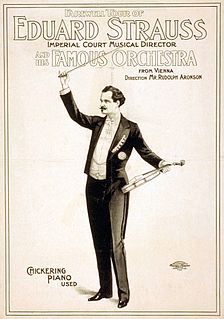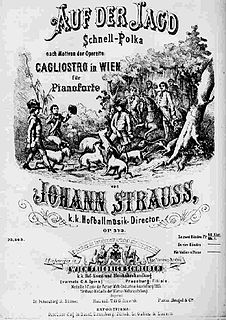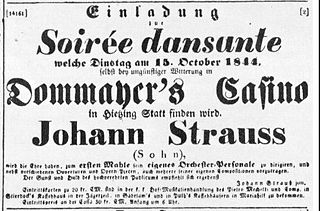Related Research Articles

Richard Georg Strauss was a German composer, conductor, pianist, and violinist. Considered a leading composer of the late Romantic and early modern eras, he has been described as a successor of Richard Wagner and Franz Liszt. Along with Gustav Mahler, he represents the late flowering of German Romanticism, in which pioneering subtleties of orchestration are combined with an advanced harmonic style.

Johann Strauss II, also known as Johann Strauss Jr., the Younger, the Son, was an Austrian composer of light music, particularly dance music and operettas. He composed over 500 waltzes, polkas, quadrilles, and other types of dance music, as well as several operettas and a ballet. In his lifetime, he was known as "The Waltz King", and was largely responsible for the popularity of the waltz in Vienna during the 19th century. Some of Johann Strauss's most famous works include "The Blue Danube", "Kaiser-Walzer", "Tales from the Vienna Woods", and the "Tritsch-Tratsch-Polka". Among his operettas, Die Fledermaus and Der Zigeunerbaron are the best known.

Johann Strauss I was an Austrian Romantic composer. He was famous for his waltzes, and he popularized them alongside Joseph Lanner, thereby setting the foundations for his sons to carry on his musical dynasty. He is best known for his composition of the Radetzky March.

Leo Strauss was a German-American political philosopher and classicist who specialized in classical political philosophy. Born in Germany to Jewish parents, Strauss later emigrated from Germany to the United States. He spent much of his career as a professor of political science at the University of Chicago, where he taught several generations of students and published fifteen books.

Franz Josef Strauss was a German politician. He was the long-time chairman of the Christian Social Union in Bavaria (CSU) from 1961 until 1988, member of the federal cabinet in different positions between 1953 and 1969 and minister-president of the state of Bavaria from 1978 until 1988. Strauss is also credited as a co-founder of European aerospace conglomerate Airbus.

Peter Lawrence Strauss is an American television and film actor, known for his roles in several television miniseries in the 1970s and 1980s. He is five-time Golden Globe Awards nominee.

Josef Strauss was an Austrian composer.

Levi Strauss & Co. is an American clothing company known worldwide for its Levi's brand of denim jeans. It was founded in May 1853 when German immigrant Levi Strauss moved from Buttenheim, Bavaria, to San Francisco, California to open a west coast branch of his brothers' New York dry goods business. The company's corporate headquarters is located in Levi's Plaza in San Francisco.

Eduard "Edi" Strauss was an Austrian composer who, together with his brothers Johann Strauss II and Josef Strauss made up the Strauss musical dynasty. He was the son of Johann Strauss I and Maria Anna Streim. The family dominated the Viennese light music world for decades, creating many waltzes and polkas for many Austrian nobility as well as dance-music enthusiasts around Europe. He was affectionately known in his family as 'Edi'.

Johann Strauss III was an Austrian composer whose father was Eduard Strauss, whose uncles were Johann Strauss II and Josef Strauss, and whose grandfather was Johann Strauss I. He was unofficially entrusted with the task of upholding his family's tradition after the dissolution of the Strauss Orchestra by his father in 1901. His talents were not fully realized during his lifetime as musical tastes had changed in the Silver Age with more popular composers such as Franz Lehár and Oscar Straus dominating the Viennese musical scene with their operettas, although his uncle, Johann Strauss II, supervised his development as a musician, a fact disputed by Eduard Strauss.
Mephistos Höllenrufe, Op. 101, is a waltz composed by Johann Strauss II in 1851. It was first performed at the Vienna Volksgarten as part of a festival preceding Strauss' departure for a tour of Germany. The title of the composition is a quotation from the Bible: "And the devil [Mephistopheles] [...] was cast into the lake of fire and brimstone, where the beast and the false prophet are, and shall be tormented day and night for ever and ever". A reporter for the Wiener Allgemeine Theaterzeitung commented on Strauss' waltz that it "received such a favourable reception, on account of its effective and original melodies and brilliant instrumentation, that it had to be repeated three times". Especially colourful, and keeping with the work's ominous title, is the second waltz theme: its cheerful, ascending tune is suddenly interrupted, and then answered by a sinister chromatic descending passage. Some of the waltz themes of the work are found in close proximity to one another in the earliest of Strauss' "sketchbooks", and were probably written in the first half of 1851.
Grillenbanner, opus 247, is a waltz composed by Johann Strauss II. Strauss himself conducted its premiere at a ball in the Sofienbad-Saal in February 1861. The work was dedicated to Prince Leopold of Saxe-Coburg-Gotha.

"Auf der Jagd", op. 373, is a polka composed by Johann Strauss II. The composition is based on melodies in Strauss' operetta Cagliostro in Wien.

Gunstwerber, Op. 4, is a waltz by Johann Strauss II.
Indigo-Marsch, opus 349, is a march composed by Johann Strauss II. Its melodies are incorporated from Strauss' first operetta, Indigo und die vierzig Räuber. The work was first performed on 9 April 1871 at a concert in the Musikverein in Vienna, with Eduard Strauss conducting.
Aus den Bergen, opus 292, is the name of a waltz composed by Johann Strauss II. The work was first performed in Pavlovsk on October 2nd 1864, under the title In den Bergen. The composition was dedicated to the music critic Eduard Hanslick. Critics commented on Strauss' waltz that "after a long time a new waltz from Johann Strauss has appeared, which is distinguished by noble and graceful character, and further distinguished by extraordinarily masterful instrumentation." The first Viennese performance of the waltz was in the Volksgarten as part of a benefit concert commemorating Strauss' twentieth anniversary of his debut as a composer.
Rhadamantus-Klänge, Op. 94, is a waltz composed by Johann Strauss II. It was written for the 1851 Vienna Carnival. The title of the work was named after Rhadamanthus, one of the judges of the underworld in Greek mythology. Eduard Strauss, the composer's youngest brother, included the waltz's opening number in his potpourri Bluthenkranz Johann Strauss'scher Walzer, opus 292.
Lava-Ströme, opus 74, is the name of a waltz composed by Johann Strauss II. It was written to commemorate the volcanic activity within Vesuvius in 1850. The waltz was first performed at a benefit ball going under the title of a "Ball in Vesuvius" at the Sofienbad-Saal in Vienna on January 29, 1850.
The Strauss Family is a 1972 English Associated Television series of eight episodes, about the family of composers of that name, including Johann Strauss I and his sons Johann Strauss II, Eduard Strauss and Josef Strauss.

Eduard Leopold Maria Strauss, commonly known as Eduard Strauss II to distinguish him from his grandfather, was an Austrian conductor whose grandfather was Eduard Strauss I and whose uncle was Johann Strauss III.
References
- ↑ "STRAUSS II, J.: Edition - Vol. 11 CD". NaxosDirect. Retrieved 2008-10-08.
| | This article about a classical composition is a stub. You can help Wikipedia by expanding it. |